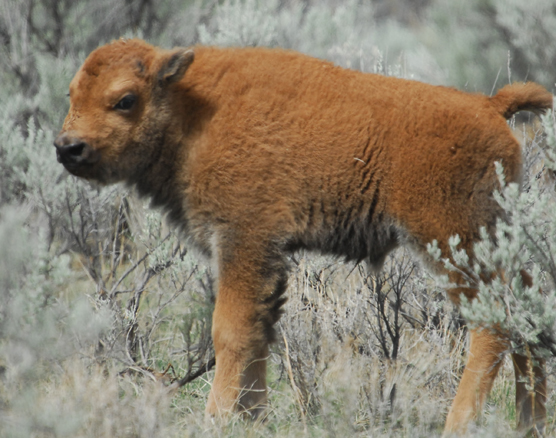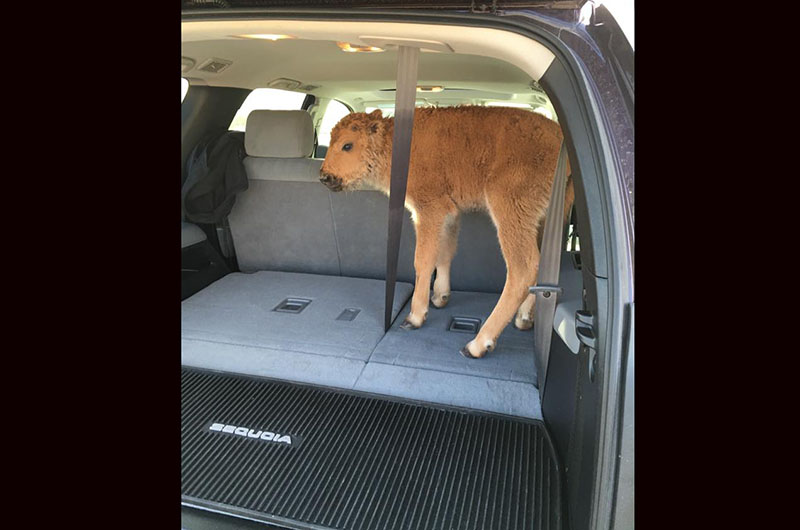Emotions ran high following a recent event here in Yellowstone that made national headlines and international news. Tragedy unfolded after a father and son attempted to rescue a bison calf in Yellowstone National Park that they believed to be cold and under duress.
I was astonished by the viral explosion this incident prompted. Being a Yellowstone guy, and having worked in the park and throughout the ecosystem for over fifteen years, my Facebook newsfeed is full of Yellowstone lovers, converts and devotees. The bison calf story was everywhere. Anger boiled over on social media and I continued to hear the same sentiments as I guided wildlife tours in the park the week that the news broke. “What the hell is wrong with these people?” “How could they be so stupid?” “These people disgust me!” This was the overriding sentiment I encountered.
I have a slightly different take on the incident that led to a burnt orange bison calf being put down by the National Park Service after it reportedly attempted to reunite the calf with his tribe.

Photo by Nathan Varley
The news of the bison calf broke on May 16th. Two days later, I rendezvoused with sixty+ students and professors from Longwood University whom I had the privilege of guiding on Yellowstone’s Northern Range. We reconvened that evening for a spirited discussion of everything activism and Yellowstone. Near the end of my presentation, I asked the students to share their feelings about the bison calf incident. It was a topic I had heard much about throughout the day, and I had hopes of giving a different perspective. I asked these intelligent and caring young people to share the emotions that the bison calf incident inspired.
Anger. Frustration. Disbelief. These were the most common sentiments.
I wanted to explore this event from a different angle. I kept probing the students until I heard two unexpected responses. “Disconnect.” “Unaware.”
I ran with it.
I’m the first to feel outrage when Yellowstone’s wildlife and wilderness wonders are disrespected, taken advantage of, or mismanaged. But I didn’t feel anger or outrage regarding the bison calf. Having worked as a ranger naturalist in Yellowstone for seven summer seasons, I’ve seen a lot. It would be hard for anyone to make me feel disbelief. Stupid things happen EVERY day in Yellowstone. Instead I felt incredibly sad, but not angry or frustrated. No disbelief.
I’m sad for the loss of a spirited bison calf; but even more so, I’m sad that we, as a culture, have grown so disconnected to the natural world. And I’m sad for a father who took the time to journey to another country to share Yellowstone with his son. One of my office mates just told me that he saw the news of the bison calf and Canadian tourists on the television while in China. Can you imagine the grief, fear and pain this has caused this father and son?
Without knowing or speaking to the father, I can’t help but feel compassion for him. Yes, I’m a former ranger naturalist in Yellowstone, one who yearned to throw the book at every ill-witted visitor who harassed wildlife to get a better picture with his or her point-and-shoot camera. But I didn’t feel the same outrage towards this father and son. I felt empathy.
What he did was wrong. Yellowstone is a wilderness Mecca and this isn’t what this wilderness setting is about. But what this father did wasn’t malicious. It was disconnected and unaware. And I assure you that this type of thing happens far more often than anyone would ever want to believe. Here’s a father who is taking time out of his busy life, spending loads of money, traveling to the remote Northwestern corner of Wyoming, to enable his son to see our world’s first national park—and he’s being vilified for an act prompted by compassion and concern. What he did was wrong. But he didn’t harass the bison calf to get a better picture. He didn’t load the calf into his SUV to take the animal as his pet. He did what any compassionate human being would do for a stray dog. He took an animal that he perceived to be cold and struggling and brought him directly to the rangers. He clearly believed he was saving the bison.
It was a misinformed act of altruism, an act of kindness. That is how I see it anyway. And this is what I shared with a group of college student’s days after the event unfolded.
It just so happened that the same week reports of the bison calf calamity went public, a bro brah film crew from a campaign aptly named High On Life desecrated Yellowstone’s’ Vatican, by walking on the surface of Grand Prismatic, in their effort to be edgy. I found this act despicable. This film crew knew exactly what they were doing—and did it anyway. And while it created a media buzz of its own, I read little in the way of outrage on social media regarding this incident. Instead, a misguided but well-intended, uninformed father was vilified.
Sure, the father from Canada is an easy target, especially when you see a picture of that beautiful calf. Especially when you know firsthand how precious each Yellowstone bison calf is. But it doesn’t take courage to criticize a stranger who performed an ignorant act. Join the crowd, get worked up! Stand up for Yellowstone bison calves. But how many of the tens of thousands—hell, maybe hundreds of thousands—who expressed their outrage over the bison calf, have posted anything about the 90+ Yellowstone bison that were shipped to slaughter this winter, or the thousands that have been shipped to their violent deaths since 2000? It requires some guts to take Montana Fish Wildlife and Parks, Montana Department of Livestock, the National Park Service or the State of Montana—all members of the Interagency Bison Management Plan.
When it comes to the calf incident, my frustration resides more with the Law Enforcement Rangers who are often quick on the trigger. This appears to be one of those incidents. I understand their concerns that the calf represented a safety concern for oncoming motorists, but one can’t help but question the need to intervene by euthanizing the animal. From the reports, it sounds like this very well could have been a case of abandonment. It’s not uncommon for three-year-old cow bison who are not yet ready to have calves to become pregnant. After giving birth, they often abandon their young. Why not give this little guy more time to be adopted by another cow, or, let him be recycled into the food chain by wolves or bears, a regular occurrence each year in the wild—in Yellowstone?

Clearly we need to do a better job of educating the public before they enter the park, especially as our society grows more and more disconnected to wild places. I can only hope that the National Park Service uses this media firestorm as an educational opportunity to foster awareness for a wild Yellowstone. But also, in my eyes, what this all boils down to is our need to embrace vulnerability as a culture. It takes a willingness to become vulnerable to fight for bison going to slaughter, whether it be by attending a public hearing, writing a fiery op-ed, calling Governor Bullock (Montana’s governor) or Dan Wenk, the superintendent of Yellowstone, or writing a post taking on the powerhouses entrusted with watching over our iconic wildlands. It doesn’t take courage or vulnerability to pile on an unaware man who is disconnected to wildness and whose actions clearly represent a father wanting to teach his son to be compassionate—and act on that compassion.
Vulnerability is the habitat that inspires compassion and empathy, and god knows, our culture needs to foster these characteristics and values in plenty. Perhaps it’s time to cut this father some slack, to empathize with him and his boy, understand the magnitude of the fallout from his altruistic actions, and have the courage to take on the goliaths of the world—not the Davids—by picking our battles with the agencies and nonprofits (yes, the nonprofits) who are far too often putting dollars ahead of the resources that make Yellowstone, Yellowstone.
Yellowstone after all, is a peoples’ park. What better place for our culture to begin practicing the art of empathy?
~Michael W. Leach

